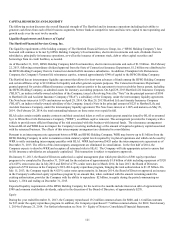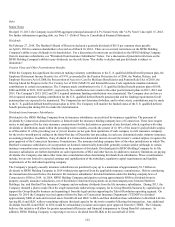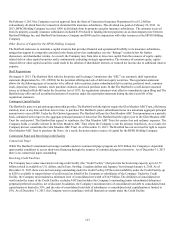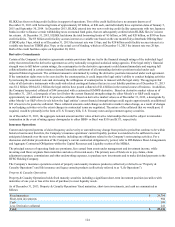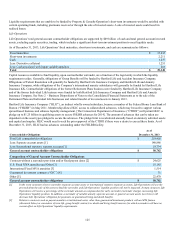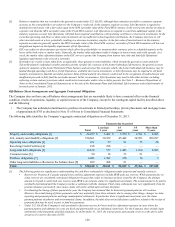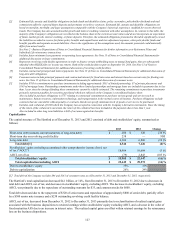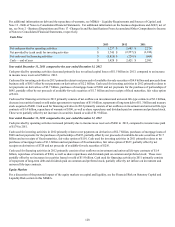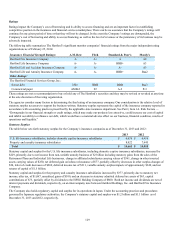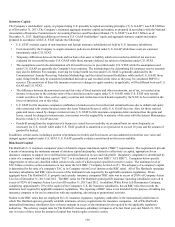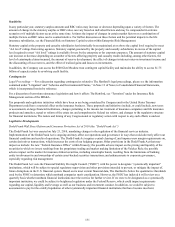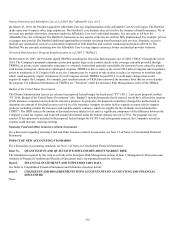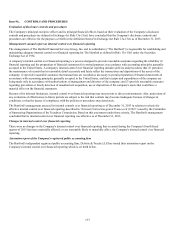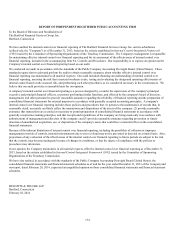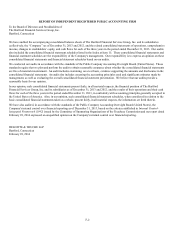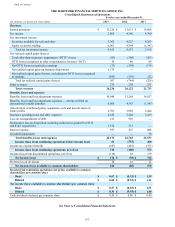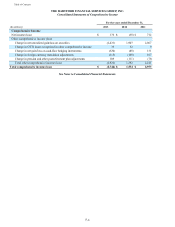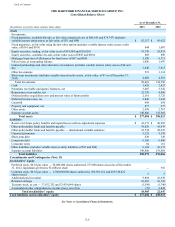The Hartford 2013 Annual Report Download - page 131
Download and view the complete annual report
Please find page 131 of the 2013 The Hartford annual report below. You can navigate through the pages in the report by either clicking on the pages listed below, or by using the keyword search tool below to find specific information within the annual report.131
Sensitivity
In any particular year, statutory surplus amounts and RBC ratios may increase or decrease depending upon a variety of factors. The
amount of change in the statutory surplus or RBC ratios can vary based on individual factors and may be compounded in extreme
scenarios or if multiple factors occur at the same time. At times the impact of changes in certain market factors or a combination of
multiple factors on RBC ratios can be counterintuitive. For further discussion on these factors and the potential impacts to the life
insurance subsidiaries, see the Financial Risk on Statutory Capital section within Enterprise Risk Management.
Statutory capital at the property and casualty subsidiaries has historically been maintained at or above the capital level required to meet
“AA level” ratings from rating agencies. Statutory capital generated by the property and casualty subsidiaries in excess of the capital
level required to meet “AA level” ratings is available for use by the enterprise or for corporate purposes. The amount of statutory capital
can increase or decrease depending on a number of factors affecting property and casualty results including, among other factors, the
level of catastrophe claims incurred, the amount of reserve development, the effect of changes in interest rates on investment income and
the discounting of loss reserves, and the effect of realized gains and losses on investments.
In addition, the Company can access the $500 Glen Meadow trust contingent capital facility and maintains the ability to access $1.75
billion of capacity under its revolving credit facility.
Contingencies
Legal Proceedings — For a discussion regarding contingencies related to The Hartford’s legal proceedings, please see the information
contained under “Litigation” and “Asbestos and Environmental Claims,” in Note 13 of Notes to Consolidated Financial Statements,
which is incorporated herein by reference.
For a discussion of terrorism reinsurance legislation and how it affects The Hartford, see “Terrorism” under the Insurance Risk
Management section of the MD&A.
Tax proposals and regulatory initiatives which have been or are being considered by Congress and/or the United States Treasury
Department could have a material effect on the insurance business. These proposals and initiatives include, or could include, new taxes
or assessments on large financial institutions, changes pertaining to the income tax treatment of insurance companies and life insurance
products and annuities, repeal or reform of the estate tax and comprehensive federal tax reform, and changes to the regulatory structure
for financial institutions. The nature and timing of any Congressional or regulatory action with respect to any such efforts is unclear.
Legislative Developments
Dodd-Frank Wall Street Reform and Consumer Protection Act of 2010 (the “Dodd-Frank Act”)
The Dodd-Frank Act was enacted on July 21, 2010, mandating changes to the regulation of the financial services industry.
Implementation of the Dodd-Frank Act is ongoing and may affect our operations and governance in ways that could adversely affect our
financial condition and results of operations. The Dodd-Frank Act requires central clearing of, and imposes new margin requirements on,
certain derivatives transactions, which increases the costs of our hedging program. Other provisions in the Dodd-Frank Act that may
impact us include: the new “Federal Insurance Office” within Treasury; the possible adverse impact on the pricing and liquidity of the
securities in which we invest resulting from the proprietary trading and market making limitation of the Volcker Rule; the possible
adverse impact on the market for insurance-linked securities, including catastrophe bonds, resulting from the limitations of banking
entity involvement in and ownership of certain asset-backed securities transactions; and enhancements to corporate governance,
especially regarding risk management.
The Dodd-Frank Act vests the Financial Stability Oversight Council (“FSOC”) with the power to designate “systemically important”
institutions, which will be subject to special regulatory supervision and other provisions intended to prevent, or mitigate the impact of,
future disruptions in the U.S. financial system. Based on its most current financial data, The Hartford is below the quantitative thresholds
used by the FSOC to determine which nonbank companies merit consideration. However, the FSOC has indicted it will review on a
quarterly basis whether nonbank financial institutions meet the metrics for further review. If we were to be designated as a systemically
important institution, we could be subject to heightened regulation under the Federal Reserve, which could impact requirements
regarding our capital, liquidity and leverage as well as our business and investment conduct. In addition, we could be subject to
assessments to pay for the orderly liquidation of other systemically important financial institutions that have become insolvent.


